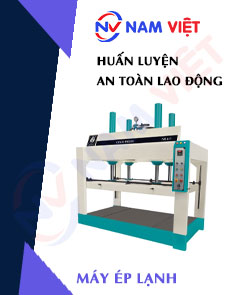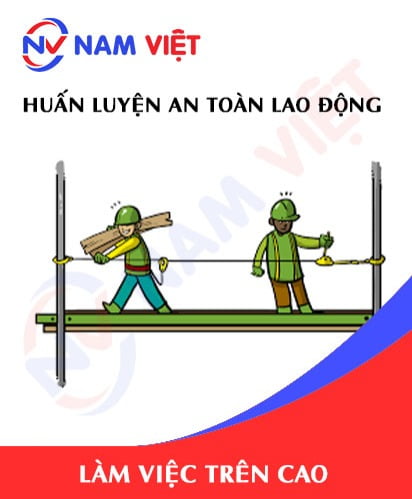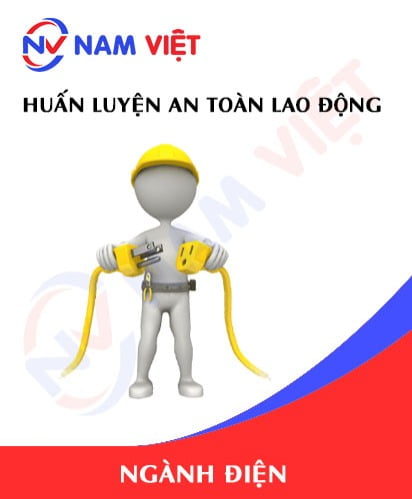Occupational Safety Training for Operating Cold Press Machines
99,000 ₫
Note: The above price is calculated per person and may vary depending on the number of trainees participating in the course and market fluctuations. For more accurate pricing support, please refer to the pricing list or contact our consulting staff directly.
Occupational safety is an important issue when operating the cold press machine and needs to be addressed promptly to ensure the health and safety of workers and enhance the reputation of businesses here. The Occupational Safety Training is one of the effective solutions to raise awareness on how to prevent occupational accidents for workers operating the cold press machine.
Table of Contents
Toggle1. Overview of Cold Press Machine
a. What is a Cold Press Machine?
Industrial cold press machines, also called cold press machines in the woodworking industry, are important equipment used to press and compress wooden panels or boards into finished products such as plywood, particle boards, or other wood products.
Specifically, the cold pressing process in the wood industry usually begins by arranging layers of wood panels in a specific format, which are then placed into the cold press machine. This machine uses pressure and low temperature to press and bond the wood layers together.
This process does not use high heat like hot pressing; instead, it applies high pressure combined with low temperature to effectively bond the wood layers. This helps preserve the mechanical and aesthetic properties of the wood while minimizing problems like crumbling or warping caused by high heat.
Industrial cold press machines in wood factories are usually large in size and designed to handle a large number of wood panels simultaneously, thereby increasing production efficiency. These machines are often computer-controlled to ensure precise and effective pressing.

b. Operating Principle of Cold Press Machine
The cold press machine in the wood industry operates based on the use of pressure and low temperature to bond wood layers effectively. Below is the basic process:
- Material Preparation: Before starting the pressing process, wood panels or boards must be prepared and arranged in a specific format. They are usually cleaned to remove dust, glue residues, or other impurities that could affect the final product quality.
- Arranging in the Press Mold: Properly prepared wood panels are arranged in the press mold or press table according to a specific structure. This ensures the panels are tightly pressed together to form the final product.
- Pressure and Low Temperature: Once the panels are correctly placed in the mold, the cold press machine is activated. It uses a mechanical or hydraulic system to apply pressure on the wood while maintaining a slightly elevated temperature above room temperature to allow effective bonding without damaging the wood structure.
- Pressing Time: Pressing can last from several minutes to hours, depending on the product type and technical requirements. During this period, pressure and temperature are kept stable to ensure uniform bonding across the product surface.
- Cooling and Removing the Mold: After pressing, the product is cooled to stabilize and fix the structure. The mold is removed, and the product is either taken for further processing or finished for final use.

c. Industries Using Cold Press Machines
Cold press machines are not only used in the woodworking industry but also applied in various other industries. Here are some of them:
- Wood Industry: Used to produce plywood, particle boards, furniture panels, flooring, doors, and other wood products. Cold pressing preserves the mechanical properties of wood and reduces warping due to high heat.
- Food Processing Industry: Used for cold-pressed juices, cold coconut milk, and other food products. This process better preserves flavor and nutritional quality compared to traditional heat-based pressing.
- Oil Production Industry: Used to extract oil from seeds such as almonds, sunflower seeds, and other food seeds. Cold pressing retains the best flavor and nutritional quality of the seed oils.
- Cosmetics Industry: Used to produce skincare creams, facial cleansers, and other cosmetic products. Cold pressing helps preserve active ingredients.
- Chemical Industry: Used to press chemical compounds or produce various chemical products.
In summary, cold press machines are versatile tools used in many industries to produce high-quality products using effective cold pressing methods.

2. Overview of Occupational Safety Training for Operating Cold Press Machine
a. What is Occupational Safety Training?
- Occupational safety training for operating cold press machines consists of sessions that raise awareness about preventing workplace accidents. Workers directly operating cold press machines belong to Group 3.
- This training helps workers identify and prevent hazards, reducing the risk of workplace accidents.
REGISTER FOR OCCUPATIONAL SAFETY TRAINING SERVICE
b. Training Duration
Initial Safety Training Duration:
- Total training time is at least 24 hours, including exam time.
- 8 hours of theory on occupational safety laws and policies
- 8 hours of theory on basic safety knowledge
- 4 hours of theory on specialized training content
- 2 hours of practical training on specialized content
- 2 hours of final theory exam
Periodic Safety Training Duration:
- Before the occupational safety card expires, workers must undergo periodic safety training, with a duration of at least 50% of the initial training duration.
Explanation: Total periodic safety training time is at least 12 hours, including exam time. After completing the course and passing the exam, workers are reissued or renewed their safety card.
c. Training Content
| No. | TRAINING CONTENT | TRAINING TIME (HOURS) | |||
| Total | Including | ||||
| Theory | Practical | Exam | |||
| I | Occupational safety laws and policies | 8 | 8 | 0 | 0 |
| 1 | Overview of legal documents on occupational safety and hygiene. | 6 | 6 | ||
| 2 | Standards and technical regulations for occupational safety and hygiene. | 1 | 1 | ||
| 3 | Specific regulations of state management agencies regarding safety when building, expanding, or renovating facilities, and for using, storing, and inspecting machines, equipment, and hazardous substances. | 1 | 1 | ||
| II | Basic knowledge of occupational safety and hygiene | 8 | 8 | 0 | 0 |
| 1 | Basic knowledge of workplace hazards. | 4 | 4 | ||
| 2 | Methods to improve working conditions. | 1 | 1 | ||
| 3 | Safety culture in production and business. | 1 | 1 | ||
| 4 | Rights and obligations of employers and workers; occupational safety policies; functions of safety officers. | 1 | 1 | ||
| 5 | Safety rules, signage, use of safety equipment and personal protective equipment; first aid skills and occupational disease prevention. | 1 | 1 | ||
| III | Specialized training content | 6 | 4 | 2 | 0 |
| Comprehensive knowledge of machines, equipment, hazardous substances; risk assessment and management; safe work procedures. | 6 | 4 | 2 | ||
| IV | Final exam | 2 | 2 | 0 | 0 |
| Total | 24 | 22 | 2 | ||
See more training content of the 6 groups
d. Occupational Safety Card
After completing the safety training and passing the exam, workers are issued a Group 3 occupational safety card (also called occupational safety certificate).
The Group 3 safety card includes information such as name, date of birth, job, work environment, training duration, official stamp, and signature confirming course completion.
According to regulations in Clause 2, Article 24 of Decree 44/2016/ND-CP, there are 2 cases:
- If there is an employment contract between the employer and the worker, the employer must stamp and sign the card after training and passing the exam.
- If the worker is freelance or temporary with no employment contract, the training unit must stamp and sign the card after the worker completes training and passes the exam.

3. Hazards for Workers Operating Cold Press Machines
Operating a cold press machine can bring many benefits in production, but it also comes with certain risks and hazards for workers. Below are some common hazards that workers may face when operating a cold press machine:
- Electrical safety risks: Cold press machines are usually electrically operated, so electrical hazards such as electric shock or fire may occur if the machine is not used or maintained properly.
- Mechanical injury risks: Cold press machines typically operate under high pressure and have fast-moving parts, which can lead to mechanical injuries such as cuts, crushing, or finger/hand entrapment if safety rules are not followed.
- Chemical and contamination risks: During operation, chemicals may be used for cleaning the machine or processing materials. Exposure to these chemicals can be harmful to health if not handled properly or if appropriate protective equipment is not worn.
- Temperature hazards: Although cold press machines operate at lower temperatures than traditional presses, high-temperature hazards may still exist on machine parts or in the working environment. Workers need proper guidance and protective equipment to prevent temperature-related risks.
- Noise hazards: Some cold press machines can generate noise during operation, especially at high intensity. Excessive noise can damage hearing if not controlled or if ear protection is not used.

4. Measures to Control Occupational Accidents When Operating Cold Press Machines
To control and reduce the risk of occupational accidents when operating cold press machines, several safety measures should be implemented. Here are some basic measures:
- Training and education: All personnel working with cold press machines must be trained on safe and effective machine operation. Training includes instructions on operating procedures, safety protocols, and emergency measures in case of incidents.
- Use of personal protective equipment (PPE): Provide and require all workers to wear appropriate PPE such as helmets, gloves, safety glasses, cut-resistant jackets, and safety shoes to protect against mechanical and chemical hazards.
- Regular inspection and maintenance: Conduct regular inspections and maintenance of cold press machines. Ensure that all machine components operate correctly and that no faults exist that could endanger workers.
- Compliance with safety rules: Establish and follow occupational safety rules, including safe workspace guidelines, proper machine usage, and emergency procedures in case of incidents.
- Monitoring and adjustment: Conduct regular monitoring of machine operation and surrounding activities. This ensures all workers comply with safety regulations and operate safely.
- Safe classification and disposal of waste: Ensure that waste generated from cold press machine operations is classified and disposed of safely, particularly chemical materials.
- Periodic inspection of cold press machines to detect early safety issues such as wear, mechanical faults, or malfunctions, thereby reducing the risk of occupational accidents.
5. Benefits of Occupational Safety Training
An Toàn Nam Việt provides businesses with the following benefits upon completing occupational safety training courses according to Decree 44/2016/ND-CP on occupational health and safety for companies and enterprises.
- Workers can identify potential hazards and take preventive measures to avoid occupational accidents.
- Businesses can establish risk prevention measures in production, operation, and maintenance processes.
- Reduce costs associated with safety incidents in the workplace.
- Uninterrupted production helps increase labor productivity and product quality.
- Compliance with labor safety laws, avoiding legal risks.
- Enhances reputation and professionalism, elevating the brand image of the business.
Nam Việt’s training courses are a solution to prevent external factors from causing harm to individuals, helping them avoid injuries or even fatalities.
REGISTER FOR OCCUPATIONAL SAFETY TRAINING SERVICES
6. Customer Feedback After Completing Training
An Toàn Nam Việt has many years of experience partnering with businesses in Vietnam, particularly in the southern provinces. This responsibility is invaluable to Nam Việt, which is why our Occupational Safety Training is increasingly professional. Our growth and success are driven by positive feedback and suggestions from our clients. Below are testimonials from our partners.
See more customer interviews after using the service of An Toàn Nam Việt
7. An Toàn Nam Việt’s Occupational Safety Training Capabilities
An Toàn Nam Việt is a reputable and quality occupational safety training center in Vietnam. Training sessions are conducted continuously at factories, production workshops, or construction sites across all 63 provinces in Vietnam.
REGISTER FOR OCCUPATIONAL SAFETY TRAINING SERVICES
Occupational Safety Training License
- An Toàn Nam Việt has been inspected and certified by the Department of Safety under the Ministry of Labor – Invalids and Social Affairs for eligibility to conduct occupational safety and hygiene training. This further reinforces our training capabilities.

Materials and Lectures
- Training materials for occupational safety courses are reviewed and approved to ensure accuracy and effectiveness.
- Our instructors’ teaching methods follow An Toàn Nam Việt standards, developed by occupational safety experts to maximize knowledge retention for trainees.
Facilities
- Controlling classroom factors improves training efficiency and knowledge retention.
- Our training facilities include spacious classrooms with adequate lighting, equipment, and training tools.
8. Nationwide Reputable and Quality Training Center
At An Toàn Nam Việt, we prioritize occupational safety training with dedication. We aim to equip workers with the knowledge to protect themselves safely while contributing to the nation.
Careful preparation ensures training effectiveness, from teaching tools, materials, and equipment to audio and lighting.
Our instructors are experts with years of experience and research in hazard identification and prevention across industries. Lectures are practical, engaging, and easy for workers to understand, following Decree 44/2016/ND-CP.
Workers learn safety measures and how to protect themselves effectively in real work scenarios.
Our training center is proud to provide professional, reliable safety training services with advantages such as:
- Competitive training costs while maintaining quality.
- Flexible scheduling to suit company production needs.
- Fast certification procedures complying with legal regulations.
- Experienced instructors.
- Controlled classroom factors for optimal knowledge retention.
- Lectures tailored to corporate safety practices.
- Dedicated and professional support for clients.

9. Additional Occupational Safety Training Materials
- Occupational Safety Training Materials Set
- Cold Press Machine Occupational Safety Materials
- Occupational Safety Training Test Set
- Cold Press Machine Safety Quiz
- Cold Press Machine Safety Training Slides
1 review for Occupational Safety Training for Operating Cold Press Machines
No comments yet















phanminhhang341
Hài lòng với cách tổ chức lớp học